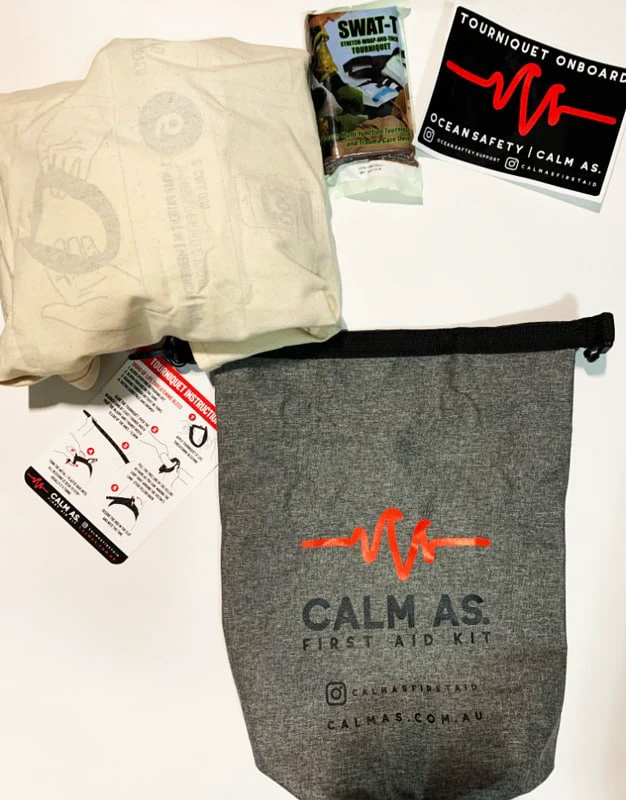Shark Attack First Aid


The mortal danger after a shark attack, is bleeding out.
Stopping the bleed is a priority in shark attack first aid. The human body has, on average, between 4.5 to 5.5 litres of blood. You can bleed out from an amputated limb in under 5 minutes.
If you feel something nudge or brush past you, it would be better to make your exit from the water, quickly and calmly, rather than stick around to investigate. Sharks are known to sometimes bump their prey before attacking.
Get to shore as quickly as you can, while sending out the alarm to anyone else in the water. Alert the lifeguard.
Sharks can sense fear. Despite it being easier said than done, try not to panic.
If a shark heads straight for you, turn and face it. Tread water so you’re in a vertical formation. By remaining vertical in the water, you’ll appear less like the shark’s regular prey, e.g. a seal, which is more often recognised as horizontal in the water.
When a shark is intent on attacking you, you can’t turn and run. Your best option is to focus your attention on the shark, so you can at least be ready to take some defensive action.
Grab any available weapon, such as a paddle or a diving knife, ready to strike at its eyes and gills. If you have no weapon, you’ll need to gouge at these vulnerable areas using your hands. Striking the snout is another sensitive spot that could be sufficient discouragement.
If you do suffer a bite, apply pressure directly to the wound to stop the bleeding. Try to swim on your back in an effort to leave the water as quickly as possible.
Once you’re out of the water, make sure others are warned, and seek first aid assistance if available. Call 000 for emergency help.
If there is no one around that can help you, follow the steps below on how to treat a shark bite.
If you begin to feel faint, lay on your side (aka the ‘recovery position’). This way, if you lose consciousness, your airway will remain open and not blocked off.
Alert a lifeguard. Call 000 immediately. Make sure others are warned.
Rescue attempts are best by boat. Do not put yourself at risk if no lifeguard or boat is available.
Help the victim out of the water as soon as it is safe to do so.
Quickly check the neck, thighs and arms to locate the sources of any bleeding.
Dial 000 for medical assistance.
If there’s an arterial bleed — where blood is spurting from the inside thigh, upper arm or leg — it will need to be quickly contained to avoid both shock and bleeding out.
Severe bleeding is life-threatening and takes priority over airway and breathing and needs to be controlled immediately.
Apply pressure directly to the wound. If pressure is not enough to control the bleeding, a tourniquet may need to be improvised.
Keep the person still and wrap them in towels for warmth, in case of shock.

A tourniquet is used to control bleeding to an injured limb. It is a tight band that is used to stop or severely reduce the flow of blood around a wound.
You can improvise a tourniquet, using a strap, a belt with a buckle, surfboard leg rope or something similar.
A towel would be your last resort for making an improvised tourniquet because, like a sponge, it would tend to draw blood out of your body.
Make sure your tourniquet is applied high and horizontal, and wind it tightly.
After applying a tourniquet, use a shirt or something similar to pack the wound and help stop the blood flow. These first aid tips could help save yourself or someone else from becoming a fatality after a shark attack.

Dr. Jon Cohen is the doctor behind the Calm As Shark Bite First Aid Slam Pack — a small waterproof knapsack that is easy to carry. It contains essential first aid items and a tea towel-sized piece of fabric with instructions.
The kit is designed for immediate action to achieve just one goal: stop the victim from bleeding out.
A tourniquet “is the holy grail in terms of preventing loss of life”, according to Dr. Cohen, a member of Surfing Doctors with advanced training in Emergency Medicine.
“Once the tourniquet’s on,” he says, “you’ve got at least 3 hours… probably more before the tourniquet starts to damage the victim. It’s the simplest thing you can do to save someone’s life.”
Disclaimer: This article is for informational purposes only. It does not constitute, replace, or qualify as any form of first aid training.

October 1, 2024
Almost every job involves using the body to carry out some type of manual task. Some tasks may be hazardous, causing injuries such as musculoskeletal disorders (MSDs). Knowing how to manage them is a legal responsibility of all workplaces.

January 10, 2024
In Australia, workplace safety is a top priority, and First Aid plays a crucial role in ensuring the well-being of employees. Workplaces are expected to adhere to specific regulations and guidelines outlined by Safe Work Australia. How does your workplace stack up?

November 24, 2023
No matter how experienced you are as an outdoor activity leader, there are some things you should always do to keep your group safe. Nature can be unpredictable, and so it’s best to be prepared.